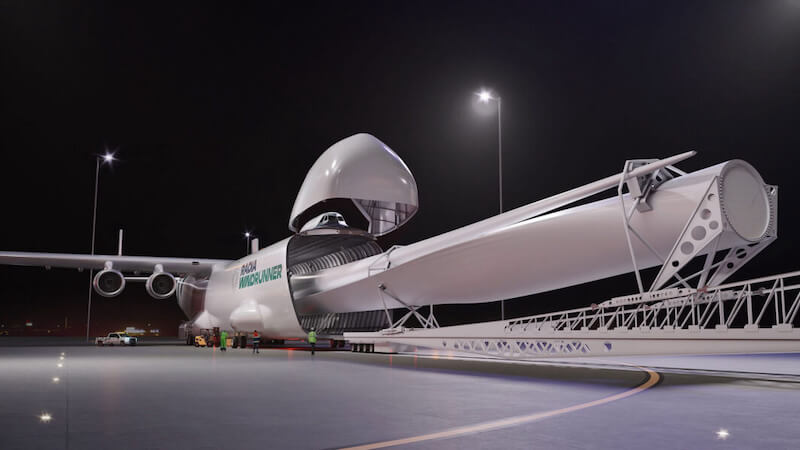
The WindRunner, the largest transport aircraft in the world, will soon be launched. Above all, it is intended to transport wind turbine components to their destination effectively and cheaply.
The expansion of wind energy continues to advance internationally. Many countries are building sometimes gigantic systems not far from the coast to convert strong gusts of wind on the high seas into sustainable energy for households. But transporting new wind turbines is often complicated and requires many permits and roadblocks.
Mark Lundstrom, an aerospace engineer trained at the Massachusetts Institute of Technology (MIT), plans to revolutionize the use of renewable energy with the development of the WindRunner. This is the largest aircraft in terms of length and cargo capacity. It is said to be specially designed for the transport of huge wind turbine components such as rotor blades.
WindRunner: Airplane enables huge wind turbines
Due to their size, rotor blades are often limited to transport by ship to offshore wind projects. However, the WindRunner could make it possible to install turbines with significantly higher output. More than seven years of research and development have already gone into the project.
The plans show that the aircraft will be almost 109 meters long. Extra-long runways are provided for take-off and landing. With the ability to transport either one large blade or up to four smaller ones at once, the WindRunner could have a major impact on the construction and efficiency of onshore wind turbines.
This would allow the turbines to reach a height that is around 91 meters above the current maximum. This is roughly equivalent to building a wind turbine the height of the Berlin television tower.
Larger turbines could reduce energy costs in the long term
The result could be a doubling of energy production. At the same time, the turbines can be erected at a large number of locations. Radia, the company behind the WindRunner, estimates that larger turbines could reduce energy costs by up to 35 percent.
At the same time, the system should contribute to the stability of the power grids through greater uniformity in power generation. Developer Lundstrom hopes that the WindRunner will also be used to transport other large equipment. Examples would be transport for military purposes or for the oil and gas industry.
According to the company, clients could save several billion euros in this way. With commercial production of the jet scheduled for late 2027 and the first customer having purchased a 1 gigawatt project in Nevada, the WindRunner is already in the starting blocks.
Also interesting:
Source: https://www.basicthinking.de/blog/2024/03/31/windrunner-flugzeug-windraeder/


